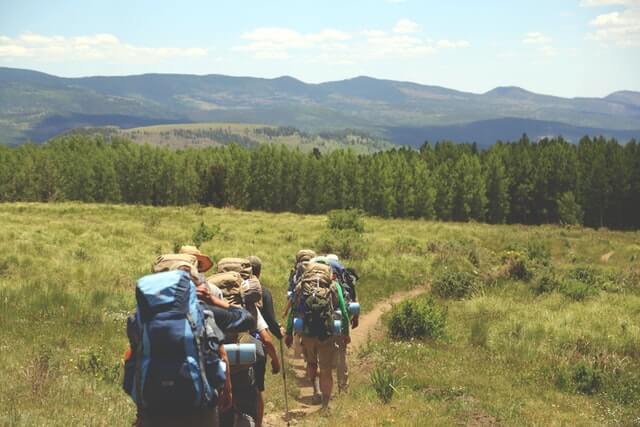When it comes to beautiful hikes, your options really are endless. Especially if you are lucky enough to have the option to travel to other countries or continents. Just remember when travelling that not all seasons are the same, and a sunshine filled summer in one country might mean you need waterproofs in another.
No matter where you are in the world there are hundreds of beautiful hikes surrounding you, both short and long in length. Some of these hikes are safe for novice hikers to go and test the water, while other hikes require only the most experienced hikers to be facing them head on.
By using technology, you may even find that one of the most picturesque hikes is right on your doorstep. However, what would make a location one of the best hikes in the world?
See also: Best Hikes in America: The Top 12 Most Scenic Routes
You also have to remember that not everything is what it looks like. You can’t judge a hike based on what you see on the photographs as it could be a much more challenging hike than you think. That’s why research is so important.
So we’re here to give you a guide to the real and best hikes in the world. We will tell you how difficult they are, how long they take to complete and why they deserve a spot on your bucket list. As hikers, it’s always nice to have another adventure planned. Who knows? Maybe you’ll make it through all of these hikes within your lifetime.
But, how do you decide which hikes deserve to be recognized as the best? A lot of hikers use a deductive system when they decide which hike they want to embark on next, so we’ve done the same. We’ve taken into consideration:
- How long is the hike?
- How long will it take to complete the hike?
- Is the hike suitable for both novice and experienced hikers?
- How difficult is the hike?
- Is the hike seasonal?
- Will it be easy to restock on a longer hike?
- Most importantly, what makes that hike special?
There is no right or wrong answer to any of the questions that we’ve considered. It has simply aided us in choosing exactly which hikes we think you should know about, ones that we think you will all enjoy.
The Hikes
Everest Base Camp, Nepal
Length: 70 miles
Completion length: Just over a fortnight.
The hike up to Everest Base Camp is often considered to be one of the most breathtakingly picturesque hikes in the world. If it were a flat hike, an experienced hiker would have it finished in just several, short days. Yet the hike up to the base camp offers something different, something that requires a lot of training before you attempt it.
While completing this hike, you have to give your body time to acclimatize to the heights that you’ll be venturing farther into. Most hikers make it up to base camp within around 10 days, although some hikers may find that their bodies take slightly longer to acclimatize to the lack of oxygen.
You should never forget to take your camera and several batteries with you if you do decide to complete the trek up to base camp. Both the scenery and the surroundings are beautiful. Imagine, you’re nestled among Himalayan giants, including Everest herself, you can’t quite imagine how small you would feel.
The Base Camp is only open pre and post-monsoon season, and it’s considered best to travel with a local Sherpa. Hiking up to base camp offers you the opportunity to experience something that most hikes don’t, a view on a different way of life. You will get to spend time with people who make their homes in the mountainous region of Nepal and experience their way of life.
Kungsleden, Sweden
Length: 65 miles
Completion length: 3 – 5 days.
There is a reason that Kungsleden, when translated literally means ‘The King’s Trail.’ Any hike that features views worthy of a King should be worthy of most modern day hikers. The thing that makes Kungsleden a hike worth embarking on is the raw beauty of the hike itself. Although you will need a bug repellent if you decide to go in the peak of summer.
Not only will you see a vast array of wildlife, you’ll also get to see giant glaciers like iced claws coming out of the ground. But these giant glaciers will only be dwarfed in size when you walk past Mount Kebnekaise, Sweden’s highest peak. You’ll get to see a mixture of icy mountains, arctic landscapes and beautiful meadows that appear to roll down the hills without end.
Kilimanjaro, Africa.
Length: 35 miles
Completion length: Around a week.
Mount Kilimanjaro is nestled deep in the backdrop of Tanzania, surrounded by forests full of wildlife. These forests contain everything from rare species of birds to blue monkeys. However, they also contain honey badgers, and as cute as their name may sound, don’t let them fool you. Like a small dog in someone’s handbag, it just waits to take the hand off of anyone who attempts to pet it.
Often you’ll see photographs of the night sky from Mount Kilimanjaro, as the stars there look beautiful, even to the human eye.
Traveling up the mountain can be incredibly draining for the body, so you should make sure to pack accordingly. It’s the highest peak in Africa, and it goes all the way up to 19,340 feet. Due to the nature of the mountain, it’s often recommended that you go as part of a guided tour, as opposed to trying to complete the hike on your own. These tours are available both early in the year and throughout the fall to avoid the monsoon season.
Chilkoot Trail, US and Canada
Length: 33 miles
Completion length: 3 – 5 days.
Chilkoot Trail spans across both Alaska and Yukon territory, and it’s best to attempt hiking the trail between June and October. The trail is usually busiest in August, when the weather is nicest. So if you’re looking for a quiet hike, try to avoid the peak of the season. The trail itself is known for its wild beauty, with its ability to show you that wildness while also showing you the immense vastness and emptiness that it spans across.
The hike also travels across a place with a colorful history, a history in gold mining, and it’s a history that you can still see today. As you hike the trail you’ll be able to see the rusting equipment that the miners themselves left more than a century ago. That’s all that remains of them today.
Must read: Best Hikes In Alaska: A Guide To An Unforgettable Hiking Experience
As you hike through the trail you will also see that the routes reference those very miners. ‘The Golden Stairs’, ‘The Golden Scales’, and ‘The Stone Crib’. You can only imagine the hardships that those miners may have faced during their time out in the wild.
Grand Canyon Hike, US
Length: 44 miles
Completion length: Just under a week.
Deep in Arizona lies the Grand Canyon, something that almost everybody seems to know about no matter where you go in the world. As a place, the Grand Canyon has both a rich history and a significant mark to science.
As a hiking location it has produced some of the most famous, jaw dropping photography locations known to man, and it’s easy to see why. Experienced hikers have been known to go back to the canyon again and again, and if you make the trip out there you will immediately know why.
With its beautifully sculpted natural architecture the canyon offers the possibility of exploration. Caves that you can explore through the way rivers once did centuries ago, a sight that seem to go for miles.
The hike also holds a brilliant scientific importance, as you can literally see the Colorado Plateau at the Grand Canyon. This offers geologists more than 2 billion years’ worth of history. It really is a significant feat and there isn’t anywhere else like it in the world. While geologists see science in the layers, hikers often see adventure.
Fitz Roy Trek, Argentina
Length: 36 miles
Completion length: Around a week.
Firstly, we would recommend doing this hike in spring, rather than summer. While summer usually is recommended to hikers, it can get incredibly busy.
Stepping onto the Fitz Roy Trek in Argentina is almost like stepping into a story book. A story book full of beech forests like something out of a horror film, giant glaciers and waterfalls louder than you can imagine. Yet the most important part of this trek is the mountains.
There are three iconic ridges that are situated on this hike and they’ve become known as the Fitz Roy Massif. You have the peaks of Poincenot, St. Exupery and the legendary Fitz Roy itself all rising out of Patagonia like something out of a dream.
There is a grand tour that you can take and it’s known to be one of the most scenic tours that one could have. As experienced hikers, we would be shocked if you don’t immediately get an adrenaline rush seeing those very mountainous peaks.
Inca Trail, Peru
Length: 26 miles.
Completion Length: Several days.
The Inca Trail in Peru is a hike that is on the bucket list of the most experienced hikers. It’s seen as an ideal hike. It takes several days to complete, and is quite possibly one of the most famous hikes in the world. Due to this, it can prove to be quite busy but with predictable weather, it is best that you go in the summer months.
When people think about the Inca Trail their first thought is often of Machu Picchu. A place of wonder and questions. It’s a 15th century citadel, situated high in the Peruvian mountains and it was abandoned centuries ago.
However, it isn’t all just ruins. The Incas who built the citadel used intuitive dry stone walling techniques to keep the building standing. The whole of the building was created with astronomical alignment in mind, so it also proves to be a spot of scientific importance.
Machu Picchu isn’t the entire hike, in fact it’s just the end of the hike. The hike itself is unique as it goes through a mixture of both mountainous landscapes and jungle regions. It’s highly recommended that you hike with a local guide for your own safety.
It would be easy to get completely lost in the deep Peruvian jungles. You will need to be an efficient hiker to conquer this hike. If you’re not an experienced hiker but you still want to take part, try to find a local guide with experience in leading newbie hikers.
Appalachian Trail, US
Length: 2180 miles.
Completion length: 5 – 8 months.
The Appalachian Trail is one of the longest trails in the world, it spans all the way from Georgia to Maine. That’s a whopping 2,180 miles to complete the entire trail. You don’t have to worry about getting lost on this incredible hike as the whole trail is continuously marked.
It really is the longest, continuous trail in the world. Around 12,000 people have completed the whole of the trail since 1937. If you’re not sure you can do the full trail initially, try hiking just a part of the trail to get a feel for it.
Check out: How to Hike the Appalachian Trail: Your Guide to the World’s Longest Thru-Hike!
Experienced hikers often take around half a year to complete this hike. It’s grueling and perfect for so many reasons. But remember that only 1 in 4 experienced hikers manage to complete the entire hike, so don’t feel like you absolutely have to complete it once you start it.
Most hikers travel northbound up the trail because it’s not a good idea to do it southbound. You would be encountering one of the most difficult mountains on the trail early on in the hike. There is always a chance of encountering wildlife on the trail, although most of the time the animals will hear you before you see them and flee.
You don’t have to worry about supplies on the trail as there are numerous spots to stop and resupply. However, keep in mind that there is a strict ‘leave no trace’ policy throughout the hike.
In Conclusion
It’s easy to read a list of hikes, what’s hard is choosing which hike is best for you. Start by turning that question around, ask yourself, which hiking location is best for me? You see, it’s easy to say you want to do all of these hikes but a lot of them require serious training. For guidelines on basic training tips to prepare for backpacking, see our earlier article on this topic.
If you’re a novice hiker, you don’t want to go darting up the Appalachian Trail for six months. However, you might find that the Chilkoot trail in Alaska and Yukon territories, or the Inca Trail in the Peruvian mountains could be perfect for you.
Neither of the trails make for easy hikes and both will require a small amount of training but there’s a good chance that you’ll complete the hike successfully. If you are a novice, you should always attempt to get a local guide to help you complete the hike.
By getting a guide you also allow yourself to be submerged into the culture that surrounds you. On the Inca trail, the locals are all from Buddhist communities and they’re incredibly friendly to most foreigners.
No matter what you decide to do, you should make sure that you have your camera with you. Be it your phone or a DSLR, all of these trails have sights that make for some postcard-worthy photographs.
So tell us, which hikes are currently on your bucket list? Or perhaps, you have been lucky enough to experience any of the hikes on our list? We would love to know all about your experiences. Let us know in the comments!







